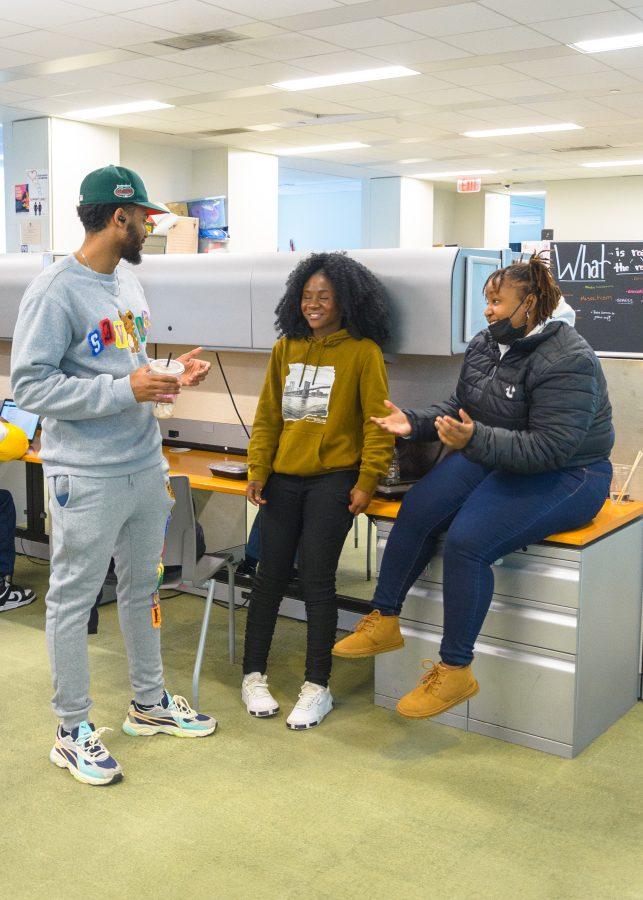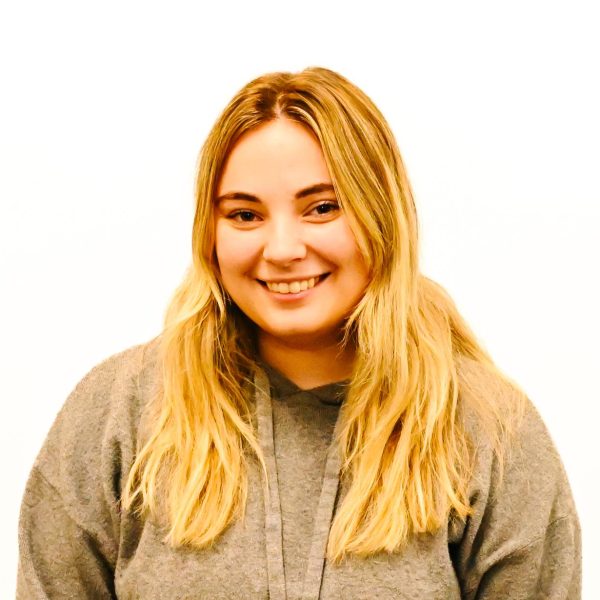Students enjoy the open club space available on the third floor of the Campus Center.
During Thanksgiving break, the leasers of club and student organizations received a notice in their emails that, over winter break, the offices on the third floor of campus center would be “refreshed.” In other words, completely revamped and reorganized.
These offices are largely home to our campus clubs, cultural organizations and student centers, including the undergraduate student government and The Mass Media. Anything that changes how these organizations are set up and run will affect the student culture of UMass Boston in a significant way. So, I wanted to take this time to do a bit of analysis on these proposed changes; what’s good? What’s bad? How will this affect the student organizations?
The main feature of this “refresh” is that the offices will be converted to more of an open floor plan. Cubicles and individual workstations will be placed along the glass walls, while the middle section will be filled with large conference-style tables and lounging areas.
My opinion of this was initially mixed. On one hand, I thought it would be an absolutely laudable goal to encourage interaction and collaboration between clubs and organizations. Interaction between clubs, in my view, would be wonderful for student culture here on campus. I think increased interaction will be especially important for The Mass Media, as we are always on the lookout for stories and topics that students care about a lot.
Although, there is more to the story. First, the total number of individual workstations is decreasing. Many people prefer working alone in a quieter, separated space and eroding that option to this extent is probably not a good idea. Second, packing cubicles along the glass wall will sort of ruin the airy vibe of the spaces. The open space might combat this a bit—it remains to be seen—but it is a consideration. This is primarily an issue with room 3300, where The Mass Media and USG are.
What stuck out to me, though, was the proposed addition of “two professional staff members that will assist in the general oversight of the space and serve as a resource to student organizations and the centers” in room 3300 with the student organizations. In fact, this development was brought to my attention due to concerns regarding the addition. The president of UMass Boston’s College Democrats club expressed concern that the new staff members would be little more than glorified hall monitors who watch over everyone in 3300.
In truth, it seems like they are simply bringing more staff members into the offices in room 3300. Evidently, the Director of Student Activities and the Director of Student Multicultural Affairs will simply be moving their offices into that space. I know the Director of Student Activities, Charles Henriques, and I think that he will be nothing but a positive influence on the space. Everyone in room 3300 already knows him, and they often go to him with questions, troubles and more. It seems to me that the Director of Student Multicultural Affairs, Anindita Sengupta, would be a valuable presence in such a multicultural space as well.
As for the style change from offices to an open plan with tables that can be reserved, it does make sense to me that the current situation—where certain clubs get permanent spaces, while others do not—can be considered a bit unfair. Why should a stamp collecting club get an office while a butterfly pinning club does not? There’s no real reason. Filling the space with easily reservable tables, open to any and all clubs, is a logical remedy.
When I talked to the president of Casa Latinx, Avishai Lorenzo-Lassus, he expressed that the student centers are pretty worried about these changes all the same. One fear is that students would not be as free and comfortable to express themselves if professional staff offices were mixed in with the student center offices. He told me that change is indeed needed—evidently, the space is in frequent chaos and does need some measure of order—but that concerns about professional staff overhearing much of what is said, thereby stifling discourse, remain.
Additionally, Avishai thinks that opening up the middle space for more interaction between groups could discourage clubs and organizations from gathering. “We have plenty of spaces like that,” he said. The fear is that, in a time where the student centers are seeing huge improvements in engagement, removing one of the only spaces where students can recharge and take respite in being around their socio-cultural peers might set back the progress made.
It’s not like the student centers are advocating for the separation of cultures. Like Avishai told me, the school has plenty of collaboration-friendly, social-mixing spaces. It’s not like the student organizations don’t ever interact with each other; they are in the same room, separated with simple dividers and rooms without doors. A modicum of privacy certainly benefits those who wish to escape the scrutiny of others, to escape constantly explaining themselves and their culture, or to be totally enveloped by the culture they love.
Personally, after hearing both sides of the issue, I think that the changes are probably a net positive. I do think that more individual desk space should be retained, and there are some seemingly unnecessary additions like more lockers and new front desks.
I also really empathize with what Avishai fears about the open plan. Actually, he’s come up with a pretty great compromise that I really could get on board with, and I hope the administration will too. Simply putting up barriers between each conference table section—maybe ones that could be moved—could go a long way in keeping that modicum of privacy.
As for the professional staff having a presence in room 3300, well, it’s pretty complicated. I always find it hard to excuse increased monitoring of any group of people—especially organizations of marginalized individuals. However, I have some idea of who these staff members will be, and I am confident that they will be an asset to the space. The problem is, who replaces them when they’re gone? Will they be just as positive of an addition? Will they help or harm the culture of the space? It’s impossible to predict.
So yeah, it’s a mixed bag. As with many things, there are good and bad aspects of it. The best thing to do, in my opinion, is to see what these changes bring, while keeping an open dialogue with the staff members and the administration. If something isn’t working, students should speak up about it and advocate for its change.
This isn’t an unmitigated disaster like most things the university does these days—it’s a reasonable plan, with the potential for both good and bad. When the bad presents itself, the students who use these spaces—myself included—need to speak up so the problem can be nipped in the bud before it gets worse. Through collaboration, we can perfect these changes so the third floor offices become even better than they are today.


